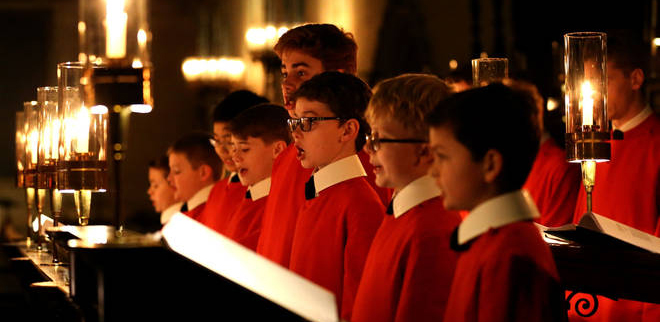The season of Advent may present a challenge for worship planners whose congregations clamor to sing Christmas carols rather than Advent hymns. After all, our ears have been beset with Christmas music since October in retail stores, restaurants and on television.
However, to go from singing “We Gather Together” immediately to “Away in the Manger” deprives us of the mystery, wonder and joyful anticipation of the Advent journey. Of the numerous Advent hymns, “O Come, O Come, Emmanuel” is one of the oldest texts we sing and has resounded through time and place from Medieval monasteries to modern worship spaces.

Beverly Howard
The source of “O Come, O Come, Emmanuel” is a set of Latin antiphons from the eighth century, commonly known as the “O” or “Great Antiphons.” Cloistered monks prayed Scripture at eight designated times within a 24-hour timeframe. These services became known as “offices.” In the span of one week, a community chanted or recited all 150 psalms and other Scripture. As these services of prayer and chant were codified, they were identified by the time of day/night they occurred:
- Matins (midnight)
- Lauds (at daybreak or 3 a.m.)
- Prime (6 a.m.)
- Terce (9 a.m.)
- Sext (noon)
- None (3 p.m.)
- Vespers (early evening or 6 p.m.)
- Compline (before retiring or 9 p.m.)
The format for each office alternated five psalms with music (antiphons, canticles, hymns), prayer and other biblical passages. An antiphon is a short sentence set to music, comparable to a modern refrain or chorus. Traditionally, an antiphon was inserted between each verse of a psalm; however, the practice eventually was abbreviated to singing an antiphon before and after a complete psalm or New Testament canticle. Vespers traditionally included the Magnificat canticle (Canticle of Mary, Luke 1:46–55) in addition to the psalms of the day.
During vespers of the last week in Advent, the community sang the “O Antiphons” preceding and following the Magnificat, anticipating the coming of the Christ Child. There are seven “O Antiphons,” one for each of the seven vesper services during that week. Anonymous authors compiled images of the coming Messiah, primarily from the Old Testament. Each antiphon begins with “O” and a title for the coming Christ, concluding with a petition related to that image.
These names provided singers a rich imagery with profound meaning. The following “O Antiphons” are identified by the Latin incipit, Scripture references, the English versification with its corresponding stanza in the hymn “O Come, O Come, Emmanuel.”
- Dec. 17: O Sapientia (Isaiah 11:2–3; 28:29), verse 2, O come, thou wisdom
- Dec. 18: O Adonai (Isaiah 11:4–5; 33:22, Micah 6:4; Exodus 19:16), verse 3, O come, O come, thou Lord of might
- Dec. 19: O Radix Jesse (Isaiah 11:1,10; Isaiah 52:15; Romans 15:11), verse 4, O come, thou root of Jesse
- Dec. 20: O Clavis David (Isaiah 9:6; 22:22; Revelation 3:7), verse 5, O come, thou key of David
- Dec. 21: O Oriens (Isaiah 9:1; 58:8; 60:18-20; Malachi 4:2; John 8:12), verse 6, O come, thou dayspring
- Dec. 22: O Rex Gentium (Isaiah 2:4; 9:5; Daniel 7:14; Ephesians 2:20), verse 7, O come, desire of nations
- Dec. 23: O Emmanuel (Isaiah 7:14; Matthew 1:23), verse 1, O come, O come, Emmanuel
The antiphon set’s traditional arrangement forms an acrostic, with the first letters of the Latin text spelling SARCORE. When read in reverse order, it spells the Latin phrase ero cras, meaning “I come tomorrow” or “I shall be (with you) tomorrow,” thus revealing the embedded message the night before Christmas Eve.
Notice the antiphon associated with stanza 1 of the modern hymn appears last in the “Os” order. By the time the hymn appears in English-language hymnals, the final antiphon appears as the first stanza.
In its journey from monastery to sanctuary, the antiphons went through numerous translations from Latin to English, both literally and poetically as versifications.
John Mason Neale (1818–1866) was a prolific writer, penning original poetry and translating ancient sacred texts from Latin. Neale’s five-stanza hymn, a paraphrase of the “O” antiphons, first appeared in Mediaeval Hymns and Sequences (1851) as “Veni, Veni, Emmanuel” (Draw nigh, draw nigh, Emmanuel). Neale made some revisions for inclusion in Hymnal Noted (1855, 1856). In the first stanza, he changed the archaic “and loose captive Israel” to “ransom captive Israel.”
For publication in Hymns Ancient and Modern (1861), Henry Baker (1821-1877) revised Neale’s “Draw nigh, draw nigh” with “O come, O come.” In the refrain, the awkward “shall be born for thee” becomes “shall come to thee.”His revisions for Hymns Ancient and Modern brought the hymn into our congregational song canon.
Other authors created translations and versifications, eventually expanding the hymn to seven stanzas. Most modern hymnal committees and editors rely on composite translations for the familiar text we sing today.
The tune veni emmanuel is based on the 15th century processional plainsong “Bone jesu, dulci cunctis.” Most hymnals retain an unmeasured notation of this plaintive melody. However, composers and recording artists continue to update this melody in many musical styles, renewing it for new generations of singers.
The Advent journey is a “between” time — a journey on which we traverse the “what was” with the “not yet.” We recall our past while yearning in hope for the coming Messiah. This “between” time affords us opportunities for reflection, with this hymn providing a perfect framework.
“O Come, O Come, Emmanuel” brings a broad list of petitions to our God-of-Many-Names. These petitions voice our hopes for the Incarnate God: Emmanuel to ransom us, Wisdom to guide our path, Key of David to open the heavenly home, Dayspring to dispel night death’s dark shadows, Desire of Nations to bind us all in God’s unity. These entreaties, although first voiced by the faithful of past centuries, still reflect our own longings and needs.
Singing the hymn in its entirety can prove overwhelming because of all the accumulated images and petitions in the text. Instead, use the week of Dec. 17-23 to echo the practice of early monks. On each day, sing only one stanza of the hymn, read or recite the Magnificat, and sing the stanza again. Ponder or meditate on the meaning of each stanza with this example of stanza six from the modern hymn:
O come, thou Dayspring, come and cheer
our spirits by thine advent here;
disperse the gloomy clouds of night,
and death’s dark shadows put to flight.
Dayspring is that mystical “between” time as daylight emerges from the darkness of night. We welcome the sun’s warmth as it dissipates the night’s chill. This stanza invokes our coming Messiah who will lighten hearts after a sleepless night spent watching over a sick friend or family member, cheer those engulfed in grief, free those ensnared by addiction, and lift burdens of people experiencing a “dark night of the soul.”
As we encounter the God-of-Many-Names in this hymn, what are our expectations? Perhaps the compilers’ original order, ending with Emmanuel, is best. While we may yearn for wisdom, power, vision, unity, it is Emmanuel, God-with-us, that fulfills those needs.
Beverly A. Howard lives in Fort Worth, Texas. She is a retired university music professor, former editor of The Hymn: A Journal of Congregational Song, and member of hymnal committees that prepared Glory to God: The Presbyterian Hymnal and Celebrating Grace: Hymnal for Baptist Worship. She is one of the collaborating authors of Sing with Understanding, Third Edition: An Introduction to the Theology of Christian Congregational Song (2022) with Martin V. Clarke, C. Michael Hawn, and Geoffrey Moore. For more on this topic, see her recent article “Singing Grace at Table: Options beyond rub-a-dub-dub, thanks for the grub,” The Hymn: A Journal of Congregational Song, Vol. 72, #2, Spring 2021.
Related article:
Salvation as deliverance and blessing: Moving from Thanksgiving through Advent to Christmas | Opinion by Stephen Shoemaker

